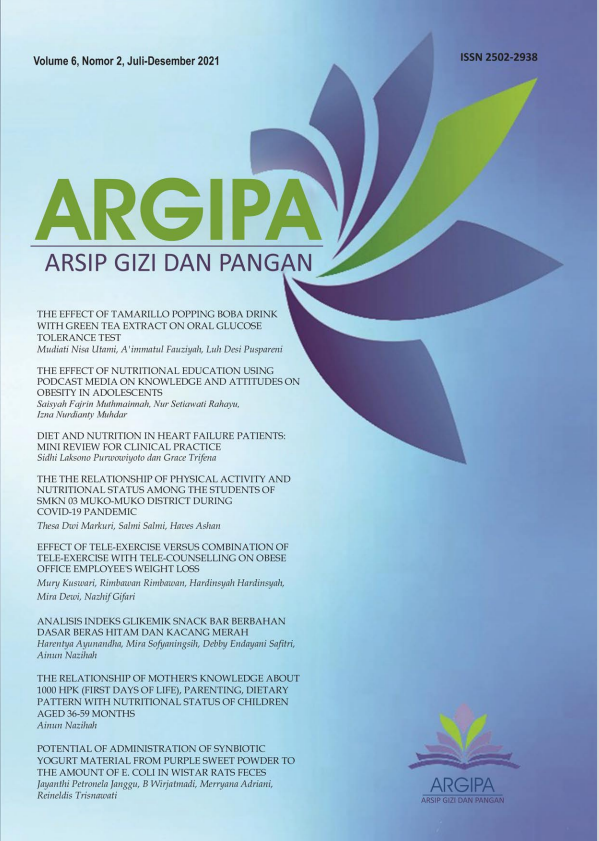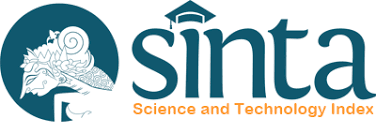The effect of tamarillo popping boba drink with green tea extract on oral glucose tolerance test
DOI:
https://doi.org/10.22236/argipa.v6i2.6630Keywords:
Blood Glucose Level, Phenol, Green Tea, Popping Boba Drink, TamarilloAbstract
Tamarillo popping boba drinks with green tea extract is an alternative product that has been developed which has a high antioxidant content of phenolic compounds so it can reduce blood glucose levels. The purpose of this study was to analyze the effect of tamarillo popping drink with the addition of green tea extract on post-prandial blood glucose levels. This study used an experimental study design method with 11 healthy adults as the subject. There were two groups in this study i.e the control group who only consumed glucose solution and the treatment group who consumed glucose solution together with the tamarillo popping drink with the addition of green tea extract. Measurement of blood glucose response was performed using the Oral Glucose Tolerance Test (OGTT) method. The results of the intervention showed that the average blood glucose level in the treatment group was lower than the control group. The results of the paired t-test broad AUC also showed that the treatment group was significantly different and lower than the control group. The results of the% PKGD calculation were 13.63%. Thus, it can be concluded that giving boba popping drink with the addition of green tea extract is effective in reducing blood glucose levels.
Downloads
References
Akbar, C. I., & Arini, F. A. (2019). Teh rambut jagung dengan penambahan daun stevia sebagai alternatif minuman fungsional bagi penderita diabetes melitus tipe 2. Jurnal Aplikasi Teknologi Pangan, 8(2), 67-73.
Aldrika, S. (2020). Pengaruh Penambahan Ekstrak Teh Hijau Terhadap Total Fenol dan Sifat Organoleptik Minuman Popping Boba Terong Belanda. Disertasi. Universitas Pembangunan Nasional Veteran Jakarta.
Asvita, S. M., & Berawi, K. N. (2016). Efektivitas ekstrak terong Belanda untuk menurunkan kadar glukosa dan kolesterol LDL darah pada pasien obesitas. Majority, 5(1), 102–106.
Bösenberg, L. H., & Van Zyl, D. G. (2008). The mechanism of action of oral antidiabetic drugs: A review of recent literature. Journal of Endocrinology, Metabolism, and Diabetes in South Africa, 13(3), 80-88.
Candrarisna, M., & Kurnianto, A. (2018). Aktivitas ekstrak kulit mahkota dewa (Phaleria macrocarpa) sebagai teraupetik diabetes melitus terhadap glukosa darah, leukosit dan hemoglobin pada tikus yang diinduksi aloksan. Jurnal Ilmiah Kedokteran Wijaya Kusuma, 7(1), 38.
Dewi, K. (2008). Pengaruh ekstrak teh hijau (Camellia Sinensis var. Assamica) terhadap penurunan berat badan, kadar trigliserida dan kolesterol total pada tikus jantan galur Wistar. Maranatha Journal of Medicine and Health, 7(2), 149509.
Diabetes Federation International. (2019). IDF Diabetes Atlas Ninth edition 2019. In International Diabetes Federation.http://www.idf.org/about-diabetes/facts-figures
Faridah, I. (2019). Pengaruh Pemberian Jelly Drink Cincau Hijau dengan Penambahan Ekstrak Teh Hijau (Camellia sinensis) terhadap Kadar Glukosa Darah Post-prandial. Skripsi. Universitas Pembangunan Nasional Veteran Jakarta.
Habuburrohman, D. dan A. Sukohar. (2018). Aktivitas antioksidan dan antimikrobial pada polifenol teh hijau. Jurnal Agromedicine Unila, 5(2), 587-591.
Hala, Y. & Ali, A. (2020). Kandungan total fenol dan kapasitas antioksidan buah lokal Indonesia sebelum dan setelah pencampuran. Prosiding Seminar Nasional Biologi FMIPA UNM.
Hidayat, F. M. T., Dananjaya R, dan Yuniarti L. (2015). Perbandingan Peningkatan Kadar Glukosa Darah Setelah Pemberian Madu, Gula Putih, dan Gula Merah pada Orang Dewasa Muda yang Berpuasa. Prosiding Pendidikan Dokter, 1(2), 69-75.
Julianti, E. D., Nurjanah, N., Yuniati, H., Ridwan, E., & Sahara, E. (2015). Pengaruh tapioka termodifikasi ekstrak teh hijau terhadap glukosa darah dan histologi pankreas tikus diabetes. Penelitian Gizi dan Makanan (The Journal of Nutrition and Food Research), 38(1), 51–60.
Kadir, N. A. A. A, Rahmat, A., & Jaafar, H. Z. E. (2015). Protective effects of tamarillo (Cyphomandra betacea) extract against high fat diet induced obesity in Sprague-Dawley rats. Journal of obesity, 2015, 1-8.
Kementerian Kesehatan RI. (2019). Laporan Hasil Riset Kesehatan Dasar (Riskesdas) Indonesia Tahun 2018. Jakarta: Badan Penelitian dan Pengembangan Kesehatan, 182–183.
Kolesi, A., & Sumarny, R. (2018). Perbandingan penurunan kadar glukosa darah ekstrak etanol daun dan biji srikaya (Annona squamosa L.) dengan metode tes toleransi glukosa oral. Jurnal Fakultas Farmasi Universitas Pancasila, 1–13.
Lee, M. (2013). Basic skills in interpreting laboratory data. American Society of Health-System Pharmacists, 5.
Mataputun, S. P., Rorong, J. A., & Pontoh, J. (2013). Aktivitas Inhibitor α-Glukosidase Ekstrak Kulit Batang Matoa (Pometia pinnata. Spp.) sebagai Agen Antihiperglikemik. Jurnal MIPA Unsrat Online, 2(2), 119–123.
National Instititues of Health Publication. (2014). www.diabetes.niddk.nih.gov.
Parisa, N. (2016). Efek ekstrak daun salam pada kadar glukosa darah. Jurnal Kedokteran Universitas Lampung Edisi Khusus PEPKI VIII, 1(2), 404-408.
Patel, M. B., & Mishra, S. M. (2012). Magnoflorine from Tinospora cordifolia stem inhibits α-glucosidase and is antiglycemic in rats. Journal of Functional Foods, 4(1), 79-86.
PERKENI, P. (2019). Pedoman pengelolaan dan pencegahan diabetes melitus tipe 2 dewasa di Indonesia. Edisi Pertama. Jakarta: PB Perkeni.
Prasetya, R. (2018). Pengaruh Suhu Penyeduhan Teh Daun Kelor (Moringa oleifera) terhadap Respon Glikemik pada Dewasa Sehat. Skripsi. Institut Pertanian Bogor.
Prawitasari, D. S. (2019). Diabetes Melitus dan Antioksidan. KELUWIH: Jurnal Kesehatan dan Kedokteran, 1(1), 48-52.
Putri, N. (2014). Pengaruh Pemberian Teh Daun Kelor (Moringa oleifera) Setelah dan Sebelum terhadap Glukosa Darah Post-Pandrial Dewasa Sehat. Skripsi. Institut Pertanian Bogor.
Rensiansi, L., & Iwaningsih, S. (2016). Pengaruh konsumsi nasi IR-36 dan nasi merah terhadap profil kadar gula darah pasien diabetes tipe 2 di Puskesmas Kecamatan Pasar Rebo Jakarta Timur. ARGIPA (Arsip Gizi dan Pangan), 1(1), 41-50.
Sadrin, Y. (2018). Penambahan Ekstrak Teh Hijau (Camelia sinensis) pada Jelly Drink Cincau Hijau (Premna oblongifolia L, Merr) sebagai Alternatif Minuman Tinggi Fenol. Skripsi. Universitas Pembangunan Nasional Veteran Jakarta.
[WHO] World Health Organization. (2014). Global status report on noncommunicable diseases 2014 (No. WHO/NMH/NVI/15.1). World Health Organization.
Widiyarti, G., Sundowo, A., & Hanafi, M. (2012). The free radical scavenging and anti-hyperglycemic activities of various gambiers available in Indonesian market. Makara Journal of Science, 15(2), 129-134.
Yuliasih, I., Sugiarto, S., & Constantia, M. (2017). Aplikasi teknik spherification pada coating sari buah jeruk. Jurnal Teknologi Industri Pertanian, 27(3), 253–260.
Zanzer, Y. C. (2011). Teh Hijau Dalam Mengontrol Level Glukosa Plasma Darah Post-prandial. Skripsi. Institut Pertanian Bogor.

















